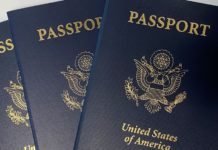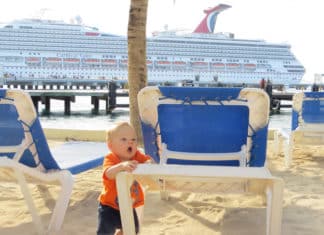There’s a major reason people love to take cruises. Yes, cruises are one of the best values for a vacation. And yes, the sun and the fun are huge draws.
But more than anything, people love to cruise because it’s easy. You just pack your bags, find your cabin, and then you’re whisked away to exotic ports while everything you could want on vacation is just a few steps away. What could be simpler?
Well, if you don’t have a passport, then it’s not always so easy.
Every cruise line has warnings that every passenger should travel with a valid passport. In fact, we also suggest that every cruise passenger have a passport.
But what many people don’t know is that in most cases you don’t have to have a passport to cruise.
That’s good news if you have a trip coming up and don’t already have one.
Why Many Cruise Passengers Want to Sail Without a Passport
Frankly, if you are only an occasional traveler, we can understand why you wouldn’t have a passport already nor be very eager to get one.
For one, new passports are somewhat expensive. A passport book costs $110, plus a $35 “execution” fee for adults. For kids, it is $80 plus a $35 fee.
So if you are taking a family of four on a trip for the first time and want to supply them all with passports, that’s more than $500 spent before you even set foot on a ship:

You can get a passport card (basically a fancy driver’s license) for only $30 ($15 for kids), plus the $35 fee. It’s cheaper, but not as versatile as a traditional passport.
For example, if something happens on your cruise and you need to fly back, the passport card does no good. It’s only valid for land and sea entries from Canada, Mexico, the Caribbean, and Bermuda.
Of course, all of these options suppose that you have the time to get a new passport before your cruise. As you can see below, it can take several weeks before you can expect yours to arrive after ordering. Some people may simply not have enough time before their trip.
Processing times vary, but routine service is currently at 10-12 weeks, or roughly three months. Expedited process is available for a higher fee, but will still take 4-6 weeks.
Luckily, a little known law helps most people from having to deal with the time or expense of getting a new passport for their cruise.
Do I Need to Have a Passport to Cruise?
If you don’t want to sail with a passport, then you’re in luck. Most people don’t need one.
That’s because of something called the Western Hemisphere Travel Initiative, or WHTI for short. Put simply, this rule says that if you embark and debark from a cruise at the same port in the United States, then you can enter the U.S. using only a birth certificate and a driver’s license.
Here’s the official language:
U.S. citizens on closed-loop cruises (cruises that begin and end at the same U.S. port) are able to enter the United States with a birth certificate and government-issued photo ID. Please be aware that you may still be required to present a passport to enter the countries your cruise ship is visiting. Check with your cruise line to ensure you have the appropriate documents.
(Note that kids under 16 can travel with just the birth certificate on closed-loop cruises. They don’t need the photo ID.)
Most cruises fall under this umbrella. So if you’re leaving from Miami, headed around the Caribbean for a week and then back to Miami, it’s considered a closed-loop cruise. For that, you only need ID and a birth certificate.
Why Suggest a Passport If You Don’t NEED It?
So if this is the case, why are the cruise lines — and Cruzely — so adamant about getting a passport in the first place?
There are a couple of reasons.
First, if anything were to happen that made you have to find alternate transport home, then you’d be in deep water without a passport. For example, if you had to fly home from a foreign port due to a family emergency, then you’d have trouble returning without a passport.
With the recent health crisis, this is more important than ever. While it’s not definite, it’s been seen that on some cruises, passengers that are positive for COVID have had to debark the ship. That means they have to find an alternate way home, such as flying.
Second, passports can make the debarkation process faster.
Not all terminals have the technology yet, but many are switching over to automated passport screening. In the old way of doing things, you leave the ship and then have to wait in line for a Customs & Border Patrol agent to check your documents before letting you into the country.
With automated screening, you scan your passport, take a quick photo, and you’re on your way. Instead of waiting in a long line, the processing takes seconds. However, those with a birth certificate still have to wait in line and have their documents manually checked.
Frequently Asked Questions
When Do I Show My Birth Certificate or Passport?
For the most part, you’ll keep your birth certificate locked away in your cabin safe or in your luggage as you travel. You’ll need to show it only when you check-in before you get on the ship and when you disembark at the end of your trip. Other that, you won’t likely show it anywhere else.
Do I Need to Bring My Birth Certificate Into Port?
No, but it wouldn’t hurt to bring a copy of it with you, just in case (leave the original in the cabin safe). When you get off the ship in port, you don’t need your birth certificate to enter or leave.
You should bring a photo ID and your cabin keycard with you as they will be checked to make sure you are supposed to be on the ship when you return.
Do I Need a Passport or Birth Certificate if Cruising to Alaska?
No, you don’t have to carry a passport to sail to Alaska. However, you do need some sort of citizenship proof, meaning either a passport or a birth certificate/ID.
But why do you need that if you are cruising to Alaska, which is part of the United States?
Cruises on foreign-flagged ships (which almost all cruise ships are), must make a stop in a foreign port before returning to the United States. Thus, any trip to Alaska will have a stop in Canada included. Since you are leaving the country, you’ll need proof of citizenship to return home.
Are There Advantages to Using a Passport Instead of a Birth Certificate to Cruise?
Yes. We discussed above how a passport gives you more flexibility if you need to return home in the middle of your cruise. While that’s rare, there is another advantage to having a passport: faster debarkation.
Today many cruise lines have switched to facial recognition to speed up debarking. You simply scan your passport, take a photo and then you are on your way off the ship. If you have a birth certificate, your documents will be manually checked and it takes much longer.
Our suggestion is to always sail with a passport that’s valid for at least six months after your cruise. But if that’s not possible, then you can sail with a birth certificate and a government-issued photo ID.
If there are any doubts, be sure to contact your cruise line well in advance of your trip.
Related Articles:
- 10 Questions and Answers to Using a Birth Certificate to Cruise
- Do I Need a Passport for an Alaskan Cruise?
- Cruise 101: Getting a Passport for Your Cruise









